Modern Development of Political Warfare and Covert Actions
It is complicated to separate the political history from the history of war; over time, they are concepts that have been separated and intertwined, forming a single doctrinal body with which to define the political relations between human groups in times of order or disorder. There is a concept that is more difficult to identify and place in the conceptual space; it is the Political Warfare.
The English government published in 1942, during the war, The Meaning, Techniques, and Methods of Political Warfare, where they limited the concept of PW to the use of publicity and propaganda, being the activity of the Political Warfare Executive highly dependent on the Ministry of Information. In that context, the English considered the use of the PW in territories where diplomatic relations had been broken, or where dangerous subversive groups existed.
Today there are still theoreticians who claim that political warfare is limited to the control of information and the dissemination of propaganda, but the concept has evolved to have a broader range of applications and provide a theoretical framework to understand many actions of unconventional warfare in the past. The Political Warfare has multiple ways to be develop, both in open and covert actions, such as public diplomacy, cultural diplomacy, economics, and of course, subversive activities.
The PW has always existed; all countries have tried to redirect in one way or another the policy of other countries towards more favorable positions for their interests. Throughout history, it can be found multiple examples of the practice of open, covert, or mixed actions. From the Trojan horse to the cyberattacks with an obscure origin, history register numerous examples of interference of very different styles.
Unites Stated Political Warfare
The more the PW concept is analyzed, the more complicated it is to define a separation line between war and politics; in the 19th century Prussian Von Clausewitz assumed that war was the continuation of politics by other means; in the twentieth century the American diplomat George Kennan assumed that the PW was the application of the military doctrine of Von Clausewitz in peacetime.
In more detail, Kennan argued in 1948 that "political warfare is the use of all means in command of a nation, except war, to achieve its national objectives. Such operations range from open actions such as political alliances, economic measures, and "white" propaganda, to covert operations such as clandestine support for "friendly" foreign groups, "black" psychological warfare and even promoting hidden resistance in hostile states. "
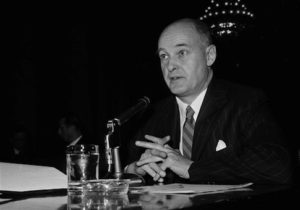
For the USSR, as for the US, the Political Warfare was also an essential element in foreign policy. That was stated by Foreign Minister Eduard Shevardnadze in front of the audience of the "Scientific and practical conference of the USSR Ministry of Foreign Affairs "in 1988" the foreign policy of the USSR is not carried only through the foreign ministry.
All the objectives achieved in recent years have been the result of proper coordination between many foreign policy departments operating under the guidance of the party. "Through active measures, Moscow tried to influence public opinion abroad while promoting political parties and subversive groups around the world.
The use of political warfare and covert actions as a foreign policy tool is not cruel or meaningless; James A. Barry, CIA intelligence analyst, links on a study covert operations with the Just War of St. Augustine. According to the author of the study, the CIA is convinced that the American population only approves of undercover actions if they are designed according to the theory of St. Augustine; that is designed from the presidency, that minimizes harm to innocent people, and that pursues a just objective.
On the other hand, analyzing in more detail the nature of undercover operations, it can be seen that it is a way to avoid a military escalation with unpredictable consequences within the disastrous. Is better to accept political realism as it is and take action on it. The new political realism made available to political actors the ideal tool to practice war, by heterodox means, without direct confrontation.
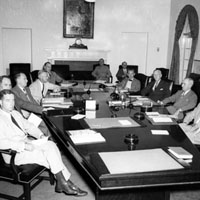
The United States began its journey as a global power after World War II by applying the Truman Doctrine and the Marshall Plan as open policies of influence abroad. But on the other hand, the Truman Administration, through the Kennan ideology, began a stage of political realism with the normalization of covert actions.
With the excuse of the expansion of communism in Europe, the National Security Council approved the NSC 10/2 plan on June 18, 1948. With this plan from propaganda to direct interference in other countries' issues was approved. In a more detailed way, the use of economic warfare, direct preventive actions, sabotage and anti-sabotage, assistance to dissident resistance, guerrillas, and refugee liberation groups, and support to indigenous anti-communist populations were approved ... Everything was prepared to execute war indirectly in peacetime.
The Office of Policy Coordination (OPC), led by OSS veteran Frank G. Wisner, emerged from NSC 10/2. In 1950, Troy Project started, in which a large group of experts developed an action plan for the execution of psychological warfare at a global level to counteract the influence of the USSR. With the approval of the NSC-68 plan that year, the use of undercover means to fight the Soviet bloc intensified. The new program said that political and economic measures to combat the Soviet sphere should include "intensification of affirmative and timely actions and operations by covert means in the field of economic and psychological warfare, aimed to foster and support subversion and riots in strategic satellites countries."
The NSC left the authority of the covert actions to the CIA, activities from which the Truman Administration took many benefits. Congresswoman Anne Karalekas, in her book History of the Central Intelligence Agency, reveals that undercover operations by the CIA became a standardized tool for US foreign policy at that time.
The Eisenhower administration ratified this PW line in 1954 with the report of General Doolittle, who argued that the rules of fair play could not continue to be the norm. He proposed "to develop effective espionage and counterintelligence services, and we must learn to subvert, sabotage and destroy our enemies by more intelligent and sophisticated means than those used against us. It may be necessary for the American people to know, understand, and support this fundamentally disgusting philosophy. "
Russian Political Warfare
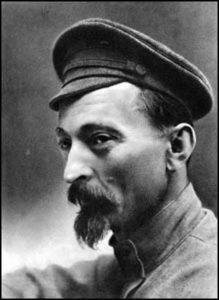
But it was not only the US that developed PW and covert operations. On the side of the USSR, активиние меропринты (active measures) concept was well theorized, and the practice was also established across the globe. Active measures included from disinformation to covert actions with varying degrees of violence.
The line evolution of organizations developing these activities has varied greatly from 1917 to 1991. After the revolution the ВЧК (Che- Ka ) was established in 1918, directed by Felix Dzerzhinsky , the NKWD in 1922, in 1923 the OPWU, in 1934 the GUGB, since 1946 МГБ (Ministry of Security of the USSR) was established, since 1954 КГБ (Комите́т Госуда́рственной Безопа́сности), Committee for State Security, known internationally as KGB. Unfortunately, most of the documents of the Russian Intelligence services are still classified.
There is more data on KGB through CIA, and through some dissident who had managed to flee, such as Yuri Bezmenovque or Stanislav Lunev (which creates doubts about its truthfulness), that by KGB itself. The history of the Political Warfare in Russia is complicated to investigate, not only because of the lack of declassified information but because of the complexity of its departments and the changes in terminology and functions over time.
One of the main differences in the development of the political warfare between Russia and the United States is that the Russian PW developed actions abroad against Western democracies, actions to influence in the third world, and internally actions against dissent. After the II GM, the Intelligence services of the USSR began their programs of active measures with misinformation and propaganda. Mainly it was done with Department D, which was later called Department of Active Measures, also dedicated to misinformation and psychological warfare.
When, in the mid-1970s, the department, directly dependent on the First General Director of the KGB, was renamed Service A, the Russian intelligence services had already developed techniques to influence Western public opinion. In any case, Vasili Mitrokhin explains in his book The Sword and the Shield that the agents assigned to these units lacked proper training and they were unaware of how life in Western countries was. This meant that the KGB's political warfare used to fall into unfounded defamations based on conspiracy theories that had more acceptance in third world countries than in western countries.
The KGB developed Political Warfare through covert actions, such as subversion, sabotage, or murder, through Department V. The activities of the KGB overlapped with those of the GRU, Directorate-General for Intelligence, which was the most reputed Russian agency of foreign intelligence, which led to friction between the two agencies. Their main collaborations were to try to create jammings in Western propaganda broadcasts.
In Russia, it can be found examples of political warfare and well-documented covert actions since the 19th century. A valuable case took place in 1888, when the Russian government promoted a mixed action to boost the Paneslavise alliances in the region and did so through the Slavic Welfare Society (SBE), which had been created in 1858 in Moscow. The association had its public diplomacy through Russian pro-Slavic authors, such as Nicolai Danilevsky, who wrote Paneslavist pamphlets.
Due to the turbulent events in the region, and the political expertise of the Bulgarian nationalist Stefan Stambolov, Alexander III decided to embark on an undercover operation. The training of a group of Bulgarian emigrants was financed through the SBE aimed to send them to the Slavic country to perform a coup d'etat that imposed a pro-Russian government. The undercover operation was a disaster due to the overwhelming defeat of the mercenary group, and because once defeated, the Bulgarian emigrants told the entire operation to the press; the operation had gone from undercover to open throughout events.
Before the 1917 revolution, Marxist groups used Russian emigrants and exiles in Europe as a subversive and pressure force in host countries. After the October Revolution, and after the Cheka secret and intelligence police were established, a counterintelligence campaign was developed between 1921 and 1926 to discredit the fleeds of the white army.
The campaign was trying to convince them to return to Russia through an association that pretended to be anti-Bolshevik resistance; Монархическое объединение Центральной России (МОЦР) (Monarchical Union of Central Russia). The operation was called "Трест" (Trust), and it got many members of the white army back to Russia to be executed. The NKVD was very successful in later years in eliminating Trotskyist dissent, both in Russia and abroad; they managed to assassinate Trotsky in the city of Mexico.
With the Soviet bloc consolidated as one of the two global powers, the active measures were combined with larger actions; Political influence operations included the creation of front organizations, such as the World Peace Council, or the World Federation of Free Trade Unions. The USSR developed an extensive network of world organizations that depended or were influenced by Moscow policy.
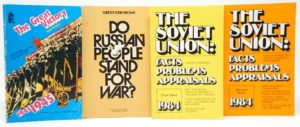
At the same time, Moscow financed a vast network of publications where they could disseminate the misinformation or propaganda that they could not place in the prestigious western publications. The USSR had its news agencies, such as Novoski, whose journalists used to be both KGB agents; There are numerous cases of journalists imprisoned and deported for promoting subversion and agitation in host countries.
Another tactic used by the USSR was the fabrication of false confidential documents for the secret services of other countries to use as if they were good. But the largest Soviet Political Warfare and covert actions was the financing of political parties, mainly communist and socialist, to influence national policies of countries around the world.
Even so, the financing structure was not as efficient as can be assumed; In January 1980, the Russian ambassador to New Zealand was arrested when he was caught giving money to the leader of the Socialist Unity Party. In short, the active measures of the USSR were exercised at a global level, but without sufficient skill to influence Western societies decisively.
Department V of the KGB had its expertise in sabotage and subversion actions and had multiple sabotage plans for power networks and water supplies in the US. The mandate of the KGB with Yuri Andropov started with the spring of Prague and the crushing of the reformists,; the KGB underwent a paradigm shift.
Italian case; quintessence of Political Warfare in Cold War
By the very political nature of the United States, its Political Warfare and covert actions are widely documented, and there is abundant declassified information. One of the most controversial examples of the application was the US intervention in the Italian elections of 1948.
With the imminent threat of the spread of communism in Europe, and in a rush to impose the perception of American victory, US officials embarked on a mixed PW action that included public diplomacy with white propaganda, and covert operations with black propaganda and financing of political parties.
The film began with the American ambassador James Clement Dunn announcing the arrival of aid to the country and highlighting across all media that without American help, life in Italy would be harder. Multiple local actors were developing a role in the scene, from the Christian Democratic party to the Social Democratic party, and including the Vatican.
Italy was a field of experiments for the subsequent development of American undercover actions. One of Dunn's first observations was the immense difference between the abundant communist propaganda in Italy and the scarce American propaganda. It didn't take long for the embassy to flood the streets with white propaganda, which was quickly neutralized with the black propaganda that the USSR applied through the Italian press.
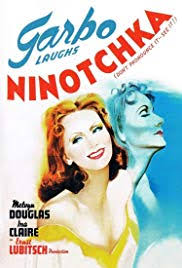 The psychological warfare was much disputed in Italy; it got to involve Greta Garbo in its interpretation in Ninotchka. As Tony Shaw explains in Hollywood Cold War, the influence of the Vatican in the elections was greater than that of the film, but still, the cinema was the best channel to connect state propaganda with the public.
The psychological warfare was much disputed in Italy; it got to involve Greta Garbo in its interpretation in Ninotchka. As Tony Shaw explains in Hollywood Cold War, the influence of the Vatican in the elections was greater than that of the film, but still, the cinema was the best channel to connect state propaganda with the public.
The Italian communist parties started a sabotage campaign against the screening of the film, which was surely more counterproductive than the mere screening of the film. The American PW in Italy covered all aspects that the PW can include, and the play went well.
The CIA perfected Political Warfare techniques, and there are many references of its application worldwide; The campaign in Chile lasted more than a decade in which undercover actions financed political parties, propaganda in the press, and openly fostered a military coup d'etat. Similar activities occurred in the coup d 'état of Iran, or the multiple operations in Syria ... it is difficult to find an event of international relevance in which the CIA is not involved in one way or another.
Political warfare is complex to carry out; public diplomacy must be synchronized with covert actions, and with clandestine actions (which are those that are done without informing the congress). The Political Warfare has to disseminate white, black, and gray propaganda, create alliances with dissidents, and promote subversive actions.
When the Political Warfare and covert actions works together, the primary master line of a covert operation cannot be crossed; the organizing actor must always be left out and in the shadow. All covert actions must be possible to be denied. The theory to execute effective covert actions is very well developed; differentiate information and propaganda, which means that information for allies is Public Diplomacy, while information for the enemy is PSYOPS.
The organizer must be able to develop the infiltration in the chosen state, through political parties, elites, influencers, front organizations ... It must execute operations through counter-elites, atomize and neutralize social and political organizations, and make a change of government. There is nothing new under the sun, and today there is nothing more suspicious than spontaneous subversive actions or mass media devices with a unidirectional and straightforward narrative.
Finding these two models always means that there is an operation within a strategy that seeks to alter the current state of the social order. The Political Warfare has always been on the game-board of international relations, and always will be.
 Copyright secured by Digiprove © 2020 Quixote Globe
Copyright secured by Digiprove © 2020 Quixote Globe